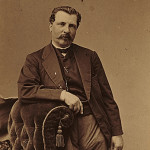Part of a fasces
Now, it would probably be easy to answer this one if you knew was a fasces was – otherwise, it might be a real head-scratcher. For all you Latin fans, fasces is the plural of fascis, meaning “bundle”. A fasces is a bound bundle of rods and occasionally includes a blade. So, part of a fasces is a rod. You knew that Latin would come back to haunt you, didn’t you?
But wait, there’s more! The fasces has its origins in Etruscan civilization – where it symbolized the power of the magistrate. Many believe that the group of rods re presents strength through unity. The symbol was used in the Roman empire and has been used ever since in various governments and groups.
presents strength through unity. The symbol was used in the Roman empire and has been used ever since in various governments and groups.
Today, you can see fasces all over the place – the Oval Office, the United States Senate, the House of Representatives, Coit Tower, and the National Guard Bureau insignia which appears at right. There are numerous other examples as well.
James Merritt _____, pioneering lithographer
James Merritt Ives(March 5, 1824 – January 3, 1895) was an American lithographer, and businessman. With his partner, Nathaniel Currier, he managed the financial side of their successful firm, Currier and Ives. Of interest is the fact that Ives had no formal art education, garnering his knowledge through study and visiting the Astor library and art galleries.
His wife, Caroline Clark, was the sister-in-law of Charles Currier (brother of Nathaniel). The two were introduced, and to his credit, Nathaniel Currier recognized the business acumen in the younger Ives and soon made him the manager of his lithograph company and subsequently, partner.
The two were extremely successful in their production of lithographs – many were black and white drawings – the colored prints were done in house or contracted out to individuals. They also sold the black and white drawings with instructions on how best to complete them. The firm was managed by their sons after their deaths until it was liquidated in 1907.
Novelist O’Flaherty
Liam O’Flaherty, (August 28, 1896—died September 7, 1984), Irish novelist and short-story writer, considered to be a leading figure of the Irish Renaissance.
O’Flaherty abandoned his training for the priesthood and embarked on a varied career as a soldier in World War I and traveled widely in South America, Canada, the United States, and the Middle East. Working in various occupations such as lumberjack, porter, miner, factory worker, dishwasher, bank clerk, and deckhand, he tried his hand in numerous fields.
After his part during the revolution in Ireland, O’Flaherty later settled in England in returning to Dublin in the mid-1920s. Among his books were Thy Neighbour’s Wife , a successful first novel; The Black Soul , The Informer later adapted by John Ford into an Oscar-winning film by John Ford, Skerrett, and, Famine a story of the effect of the Irish famine of the 1840s on the individuals of a small community; Short Stories , Insurrection a novel about the Easter Rising of 1916; The Pedlar’s Revenge and Other Stories -as well as several other works. His autobiography, Shame the Devil, was published in 1934.

